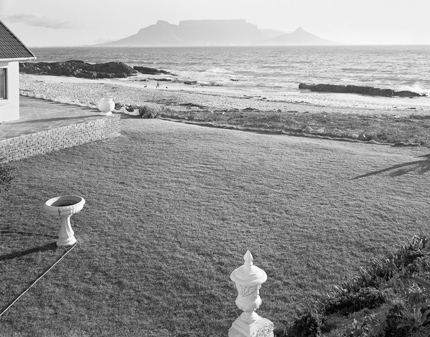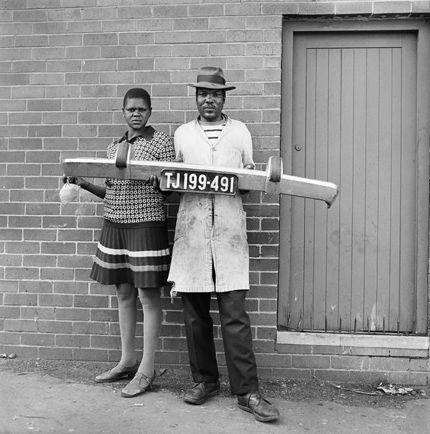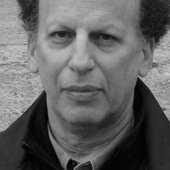
At Kevin Kwanele’s Takwaito Barber, Lansdowne Road, Khayelitsha, Cape Town, in the time of AIDS, 16 May 2007. All photos courtesy New Museum
I often wished during those years that I could be a lyricist with a camera. I would look at Edward Weston’s work and envy the freedom to be lyrical. I took great delight in his and many other photographers’ work. I envied them the freedom to photograph a landscape apparently without concern for the implications of its possession.
—David Goldblatt, Interview with Okwui Enwezor, 1998
For most of David Goldblatt’s career, which began in the early 1960s, nearly everything that he saw was contextualized by the distorting prism of apartheid. The ownership and use of land, as well as housing, jobs, marriage, schooling and countless other facets of everyday life, were all powerfully linked to the color of one’s skin. Partially as a result, Goldblatt chose to photograph the manifestations of apartheid in shades of gray until, after Nelson Mandela’s ascension, his medium evolved into color. “During those years color seemed too sweet a medium to express the anger, disgust and fear that apartheid inspired,” the photographer told photo historian Mark Haworth-Booth in the beautifully produced 2005 book Intersections, a volume that precedes the exhibition “Intersections Intersected: The Photography of David Goldblatt,” on view at New York’s New Museum through October 11.

Suburban garden and Table Mountain, Bloubergstrand, Cape Town, 9 January 1986
A member of a Lithuanian Jewish family that had come to South Africa to escape religious persecution, Goldblatt described himself as a “self-appointed observer and critic of the society into which I was born.” And he was, choosing a probing, dispassionate style of photography that sought complexity and nuance, rather than an overtly activist stance. “I said that the camera was not a machine-gun and that photographers shouldn’t confuse their response to the politics of the country with their role as photographers,” he explained to the curator and critic Okwui Enwezor.
While in many societies, photographers gravitate toward the marginal — drug addicts and musicians, runaways and prostitutes — in pre-1994 South Africa the marginalized were the vast majority. Goldblatt photographed many such individuals, as well as whites, with enough understatement that it is often the accompanying captions and short texts which are relied upon to provide the occasional exclamation marks. His work, while formal and at times even deferential, can also be furious, undercutting twisted classifications with an otherwise polite gaze and pointed remark. For example, two young black people on the street hold a car’s fender. The caption: “She said to him, ‘You be the driver and I’ll be the Madam’. Then they picked up the fender and posed, Hillbrow, Johannesburg, 1975.” Or, a quiet image of an unoccupied room: “In the Docrats’ home before its destruction under the Group Areas Act, Fietas, Johannesburg, January 1977.”

She said to him, ‘You be the driver and I’ll be the Madam’. Then they picked up the fender and posed, Hillbrow, Johannesburg, 1975
Recently, as he employs color and large prints and explores newer digital printing processes, his more oblique and nuanced photographs seem the result of patiently holding an enormous magnifying glass, distancing the viewer so as to better see the competing details. Rather than light privileging a subject selectively, these images strive for a non-hierarchical revealing of all nearly at once so as to lead the viewer to search for the irony in the less obvious particulars. Hung unceremoniously on clips, they pivot less on our ability to read people’s expressions than on our sensitivity, often aided by his small texts, to subtle variations in ground-level iconography. Finding the fading red ribbons on walls in intricate images, we become aware of the pandemic of AIDS both for its pervasiveness and the resignation that makes it yet another of many problems. A never-completed housing project for people living in shacks is a distant and nearly forgotten backdrop in a semi-lyrical landscape that subtly foregrounds a leftover children’s game of stones.
At times the older, more direct black-and-white image is compared with a much larger and more equivocal color image: A sadly symbolic photo concerning the assassination of anti-apartheid activists entitled “After their funeral, a child salutes the Cradock Four, Cradock, Eastern Cape, 20 July 1985,” is hung next to a much larger 2004 image that shows, in painfully banal color, a fenced-in, functional stone memorial to the four that is partially obscured by a tasteless white sign from the South African Heritage Resources Agency announcing that “this project has been upgraded and developed by SAHRA.”
These terse tributes and critiques together form, for a motivated viewer, a dry, intelligent, at times thorny narrative of South Africa’s arc, its post-apartheid redemption and chaos. “Long ago I tried to make pictures that were like those that came from Europe, soft and beautifully modulated. It used to break my heart — I could never get my pictures to look like that,” Goldblatt told Enwezor. “Then, in 1961, I realized that it had to do with light. We have a lot of it in South Africa, and it is often sharp and harsh. So instead of fighting our light, I began to enjoy it and to work with it. I photographed from within rather than as if I were visiting from somewhere else.”
In a globalized world, it is even more difficult to remember that photography is not a universal language. The photograph is never a simple record of what is there, and in the best cases represents a process of intuiting meaning without relying on pre-existing templates. In Goldblatt’s newer work, the photographer’s sensibility is more acute but also more obscured, so that the unsuspecting reader might feel that the camera, mechanically, has done the great majority of the work. This would be both an error and praise for a man who has, with great discipline and rare modesty, spent nearly half a century tenaciously pursuing, as he put it, photography as “a political inquiry, an interest in real things.”

A house-painter at home with his family, Pretoria Street, Hillbrow, Johannesburg, January 1973
Audio files featuring David Goldblatt commenting on his work, courtesy New Museum


Comments [2]
08.29.09
05:06
I was interested to hear his comment on South African light, partly because I have seen a documentary devoted to the phenomenon of 'Dutch Light' and because it is always illuminating to realise that there was a time when someone who has worked so long and hard at something, was able to discover something new. Of course, it seems that Goldblatt is probably still discovering new things.
The first photograph in your post came out of a video shoot I did with David Goldblatt in 2007. Goldblatt sent me on a recce to find the red ribbon in the Cape Town landscape. This hair salon in Khayelitsha was one of the places I found.
Please visit our web site for a little more on this story: http://www.freerangefilms.co.za/new-posts/coverstory/
Regards
TLS
08.29.09
11:48